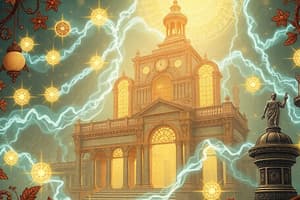Podcast
Questions and Answers
किसका मूल्य सीखने और प्राप्त करने की क्षमता कारक है?
किसका मूल्य सीखने और प्राप्त करने की क्षमता कारक है?
- विद्युत यांत्र
- विद्युत श्रेणी
- विद्युत बाध्यता
- विद्युत धरोहर (correct)
किसका मूल्य परिभाषित करने के लिए कुलों का नियम महत्वपूर्ण है?
किसका मूल्य परिभाषित करने के लिए कुलों का नियम महत्वपूर्ण है?
- तापमान
- प्रकार की चार्ज (correct)
- आपसी बल
- आपसी दूरी
कौन-सा सामग्री विद्युत धारा प्रवाह को प्रत्यक्ष करने में समर्थ है?
कौन-सा सामग्री विद्युत धारा प्रवाह को प्रत्यक्ष करने में समर्थ है?
- विद्युतक
- प्लास्टिक
- रबड़
- लोहे (correct)
धार्मिक मात्राओं में संग्रहित परिपथी इकाई को क्या कहा जाता है?
धार्मिक मात्राओं में संग्रहित परिपथी इकाई को क्या कहा जाता है?
'संपर्क' के समय प्रसरित विद्युत की उत्पत्ति कहाँ होती है?
'संपर्क' के समय प्रसरित विद्युत की उत्पत्ति कहाँ होती है?
Which one of these is the most correct?
Which one of these is the most correct?
Flashcards are hidden until you start studying
Study Notes
Electric Charges and Fields
In this article, we will delve into the fascinating world of electric charges and fields, specifically focusing on the material covered in the first chapter of Class 12 physics textbooks. Our discussion will revolve around various aspects such as electric charges, conductors and insulators, and the principles governing the behavior of electric charges.
Electric Charges
Electric charges are fundamental properties associated with matter. They are responsible for creating and experiencing electric and magnetic forces. According to Coulomb's Law, the force between two charged particles depends on their respective charges and the distance between them.
Charges come in discrete units called elementary charges, which can be either positive (+) or negative (-). The fundamental unit of electric charge is the coulomb (C), named after Charles Augustin de Coulomb, who first discovered the inverse-square law for the force between charged objects.
Conductors and Insulators
Materials are classified into conductors and insulators based on their ability to conduct electricity. Conductors, such as metals, readily allow the flow of electric current, while insulators, like plastics and rubber, resist the flow of electrons.
Transference of Electrons and Friction Electricity
Frictional electricity occurs when two different materials come into contact and then separate, transferring a buildup of opposite charges. For example, when you touch a balloon rubbed with a woolen fabric and then touch your hair, the excess positive charge on the balloon causes your hair to stand up due to attraction to the negatively charged electrons in your skin.
Superposition of Electrostatic Forces and Electric Fields
The principle of superposition of electrostatic forces states that the net electric force experienced by a given object is the vector sum of the individual forces caused by all the charges involved. Similarly, the electric field due to a group of charges can be found by adding the electric fields generated by each individual charge, following the same vector addition rule.
Electric Field Lines and Their Properties
Electric field lines help visualize the electric field around charged objects. They originate on positive charges and terminate on negative charges. The tangent to an electric field line at any point represents the direction of the electric field at that location. The density of electric field lines indicates the magnitude of the electric field; areas with higher densities correspond to stronger fields.
Electric Field Due to an Electric Dipole
An electric dipole consists of two oppositely charged objects separated by a distance. The electric field due to a dipole is determined by the positions of its charges and the vector sum of the individual electric fields generated by each charge component.
In summary, Class 12 physics introduces students to fundamental concepts of electricity, starting with the understanding of electric charges and their interactions. Students learn about conductors and insulators, the transference of electrons, and the principles governing electrostatic forces between charged particles. They also explore the concept of electric fields through the study of electric field lines and dipoles. These concepts form the foundation for further studies in electricity and magnetism.
Studying That Suits You
Use AI to generate personalized quizzes and flashcards to suit your learning preferences.




